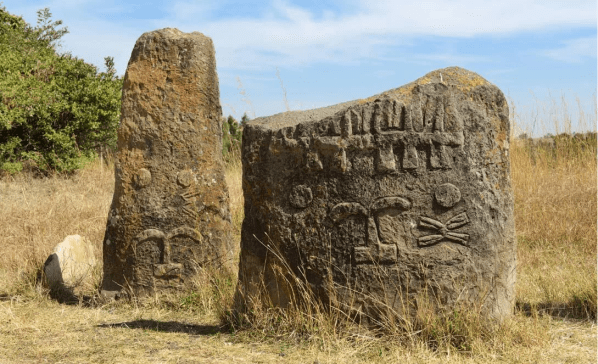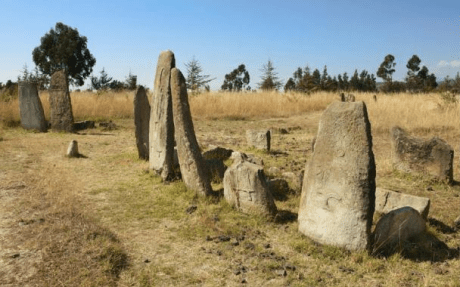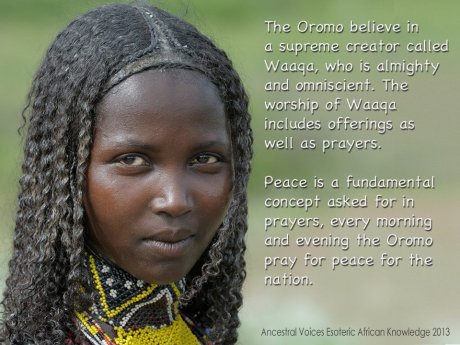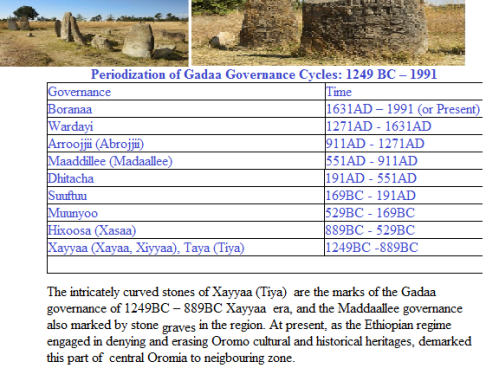Oromia and Kenya: Fascinating world of Kenya’s Borana Oromo People. #Africa. #Oromia January 24, 2015
Posted by OromianEconomist in Africa, Boran Oromo, Cushtic, Kemetic Ancient African Culture, Meroetic Oromo, Munyoo Oromo, Munyoyaya Oromo, Orma Oromo, Oromia, Oromiyaa, Oromo, Oromo Culture, Oromo Identity, Oromo Nation, Oromo Wisdom, Oromummaa, Rayya Oromo.Tags: Africa, African culture, African Studies, Borana Oromo, Kenya, Oromia, Oromiyaa, Oromo, Oromo culture, Oromo people, Oromummaa, Raya Oromo
1 comment so far
Fascinating world of Kenya’s Borana Oromo
More information about Borana can be found at www.boranavoices.org

- The majority of the 500,000-strong Borana tribe live in Kenya but some also live in Ethiopia and Somalia
- Women use clarified butter (ghee) to keep their hair in perfect condition and wear it in elaborate plaits
- Girls have the crown of their heads shaved, with the hair only allowed to grow after they marry
- Other beliefs include the fear that having your photo taken removes some blood and steals your shadow
- They also believe in a single god named Wak, although more are converting to Christianity and Islam
A nomadic people, their lives revolve around finding good grazing for their herds of camels and cattle, which combined, provide everything they need to survive in the striking semi-arid scrub land they inhabit.
But while men dominate village life and are in charge of the herds, women play a vital role and are in sole charge of building Borana homes and performing the elaborate dances that signal the birth of a baby.
Dressed in her best: A Borana woman wearing traditional garb made from goat skins. The expensive dresses are now kept only for best

Rules: Many of the Borana’s rules apply to children, including a prohibition on addressing anyone older than themselves by their first name
With so little water to be had, their beauty routine is an unusual one and involves anointing their locks with ghee (clarified butter) to keep hair smooth and shiny.
Girls are given the most striking hairdos and wear the crown of their heads shaved until they marry, at which point the hair is allowed to grow back while the rest is plaited into elaborate designs.
But hair isn’t the only part of life governed by the Borana’s centuries-old laws. The majority of rules apply to children who, for instance, aren’t allowed to call anyone older than themselves by their first names.
Those names are also governed by tribal law and are inspired by the time of day they were born. ‘Boys born in broad daylight are always called Guyo,’ explains photographer Eric Lafforgue who took these incredible pictures.
‘Some are named after a major event, a ceremony (Jil), a rainy season (Rob) or a dry season (Bon). Others are named after weekdays while a few get odd names such as Jaldes (ape), Funnan (nose), Gufu (tree stump) and Luke (lanky long legs).’
Whatever their parents decide to call them, all children are given a place in the social pecking order at birth – and once done, it is rare for it to be changed.

Welcome: The birth of a baby of either gender is marked by a traditional women-only dance which welcomes the infant into the world

Hard work: Women are in sole charge of building Borana homes and since they move four times a year, have to work extremely hard


Elaborate: A woman carries milk in an engraved gourd and shows off a bead ring (left). Right: The chief’s wife is given special jewellery

Shaved: Girls such as this one have the crowns of their heads shaved until marriage. Afterwards, hair grows back and is plaited


Changing times: Traditionally, the Borana believed in a single god called Wak. Now Islam and Christianity are beginning to make inroads



Moving: Many of the young people are leaving the tribe behind for jobs in town, among them this trio who send money home to their families

Screened: Borana women are not allowed to come face-to-face with their son-in-laws. If they do, both must immediately cover their faces
The luckiest are the sons of village chiefs who are placed in the top grade, daballe, at birth and show their status with long locks that make them resemble girls.
As future chiefs themselves, no one is allowed to punish them, even when they misbehave, while their mothers gain an honoured place in society and are frequently asked to bless well-wishers.
These women are also given special jewellery to wear usually made from colourfully beaded leather, enlivened on occasion with recycled Coca-Cola caps.
Those who aren’t married to a chief, although often forced to share a husband, do get some special benefits including being in sole charge of who can and cannot enter their homes – spouses included.
‘A wife always decides who will enter in the house,’ explains Lafforgue. ‘If her husband comes back and finds another man’s spear stuck into the ground outside her house, he cannot go in.’
Women are also in sole charge of raising their daughters and usually insist that they become excellent housewives. Men, when they come to choose a wife, will often judge the girl by her mother, which makes getting it right all the more important.
Older women are honoured as the keepers of tribal lore, although not all of it makes sense to Western ears. ‘Old people are afraid of having their picture taken,’ says Lafforgue. ‘They believe that when you take their photo, you remove their blood and steal their shadow.’

New religion: An increasing number of Borana are becoming Muslim and have adopted Islamic customs such as the headscarf


Respected: Older women are honoured as keepers of village lore while this boy (right) is the son of a chief and can never be punished

Important man: This man is the overseer of one of the Borana’s network of wells. It is taboo to fight over water

Chief: The Borana elect a leader every eight years. The ‘father of the village’ wears a special headdress called a kalacha

Home: Women have the final say on who can enter their homes. If a man finds another man’s spear outside his wife’s hut, he can’t go in

Laborious: Women are tasked with building all the houses, as well as dismantling and rebuilding them when the village moves on

Livelihood: The Borana’s cattle and camels are their most precious possessions and are nearly always cared for by men
Sorce: TKG News
For more click Borana Voices
Source: http://ayyaantuu.com/horn-of-africa-news/oromia/fascinating-world-of-kenyas-borana-oromo-tribe-revealed/
Oromia: The Intricately Carved Xayyaa (Tiya) Megaliths of Gadaa Oromo Heritage of 1249BC – 889BC January 14, 2015
Posted by OromianEconomist in Africa, Gadaa System, Maaddillee Oromo, Munyoo Oromo, Munyoyaya Oromo, Oromiyaa, Oromo, Rayya Oromo, Waata Oromo, Wardei Oromo, Xayyaa Oromo.Tags: Africa, African culture, African Studies, Gadaa System, Oromiyaa, Oromo, Oromo culture, Oromo people, Oromummaa, Xaayyaa (Tiya) Oromo Gadaa Heritage, Xayyaa (Xiyyaa) or Tiya, Xayyaa Oromo
4 comments
Philosopher and Social Anthropologist Prof. Gammachu Magarsaa has so far periodized 9 Gadaa Oromo Governance cycles for the time since 1249BC in which one cycle takes 360 years. We can see as follows:
The intricately curved stones of Xayyaa (Tiya) are the marks of the Gadaa governance of 1249BC – 889BC Xayyaa era, and the Maddillee governance also marked by stone graves in the region. At present, as the Ethiopian regime engaged in denying and erasing Oromo cultural and historical heritages, redistricted this part of central Oromia to neighboring zone.
So, in reading the following article we must refer to the above study.
The Intricately Carved Tiya Megaliths of Ethiopia

January 13, 2015 (Ancient Origins) — The Tiya stones are part of an archaeological site located in central Ethiopia, in an area known as the Gurage Zone. The 46 large, decorated Tiya megaliths have been declared a UNESCO World Heritage Site. Although the construction of such megaliths is an ancient tradition in Ethiopia, the Tiya stones are fairly ‘recent’, dating to sometime between the 10th and 15th centuries. Remarkably little is known about the Tiya stelae, beyond descriptions of their physical appearance. These large monuments likely had some cultural significance when erected, but their meaning remains unclear and very few efforts have been made towards understanding these magnificent monoliths.
The town of Tiya is found in central Ethiopia, located in the Soddo Region, in an area known as the Gurage Zone. Over 100 stelae can be found scattered across nine distinct megalithic pillar sites within the zone, 46 of which can be found at Tiya.

The pillar sites contain large stelae (monuments) of three types – anthropomorphic, phallic, and non-anthropomorphic/non-phallic. Anthropomorphic stelae are those which are given a human form. Phallic stelae are tall, thin shafts. The final stelae are flat monuments that take on neither an anthropomorphic nor phallic form, yet still take on the same basic form as the other megaliths. Each of these types of stelae are prominent within the nine sites of the Gurage Zone. Additionally, most of the stelae in the Gurage Zone contain elaborate decorations, including symbols that resemble plants, swords, and human figures, standing “akimbo,” with their hands on their hips and elbows turned out.
The monoliths at Tiya are taller than the stelae found elsewhere in the zone, with the tallest reaching over 16 feet (5 meters) high. Thirty two of the Tiya stelae bear decorative symbols.
In April 1935, one of the Tiya stones, engraved with a sword symbol, was discovered during a German expedition. Local residents refer to the stelae as Yegran Dingay, or Gran’s Stone. This is in reference to the ruler of the Adal Sultanate, Imam Ahmad ibn Ibrahim al-Ghazi. In addition to the stelae at Tiya, there have been other finds of archaeological significance. During excavations, several tombs have been found. In the area, researchers have also discovered tools form the Middle Stone Age. Several sets of remains have been found in the area, with the bodies dating to sometime between the 12th and 14th centuries. Upon examination, it appeared that the remains belonged to individuals who were killed in battle. This may be fitting, as some say that the Tiya stones appear to be laid out like a row of headstones. There has been speculation that these are, perhaps, the site of a mass burial for those killed in battle.

The Tiya stelae are similar to stelae found in other areas, such as those that can be found en route between Djibouti City and Loyada. The stelae near Djibouti City include anthropomorphic and phallic stelae, and some of those near Loyada contain a T-shaped symbol. Some of these stelae also contain the symbols found on the Tiya stelae.

The Tiya stones were declared to be a UNESCO World Heritage Site in 1980. A UNESCO World Heritage Site is a place that is considered to be of special cultural or physical significance. These worldwide sites are protected in hopes of preserving any cultural significance they may hold. The site of the Tiya stones joins many other UNESCO World Heritage Sites in Ethiopia, including: Axum, Lalibela, Semien Mountains National Park, Fasiledes Castle, the lower Valley of the Awash River, the lower Valley of the Omo, Muslim Holy City Harar, and the Konso Landscape. Altogether, these sites are the important remains of ancient Ethiopian culture, although it has been said that there has not been enough effort towards understanding the archaeology of Ethiopia.
Fully understanding the purpose and function of the Tiya stones is difficult because of the small amount of research that has been done in the area. Identification as a UNESCO World Heritage Site should be helpful towards learning more about the stelae, but surprisingly little has been done in the past 35 years since that occurred.
 Sites such as the Tiya stones should be protected to ensure that any cultural secrets they hold will remain preserved, and perhaps someday be discovered. As a site created by the ancestors of those who live in Tiya and nearby areas, any significance of the megaliths may still apply to those who live there today. By protecting the site, UNESCO and other interested groups can ensure that the stones are preserved for future generations. There is the hope that more research will be undertaken in order to learn more about the amazing megaliths at Tiya, including who constructed them, why they did so, and what significance the monuments hold.
Sites such as the Tiya stones should be protected to ensure that any cultural secrets they hold will remain preserved, and perhaps someday be discovered. As a site created by the ancestors of those who live in Tiya and nearby areas, any significance of the megaliths may still apply to those who live there today. By protecting the site, UNESCO and other interested groups can ensure that the stones are preserved for future generations. There is the hope that more research will be undertaken in order to learn more about the amazing megaliths at Tiya, including who constructed them, why they did so, and what significance the monuments hold.
Source: Ancient Origins
http://ayyaantuu.com/horn-of-africa-news/the-intricately-carved-tiya-megaliths-of-ethiopia/
Copyright © OromianEconomist 2015 & Oromia Quarterly 1997-2015, all rights are reserved. Disclaimer.





You must be logged in to post a comment.